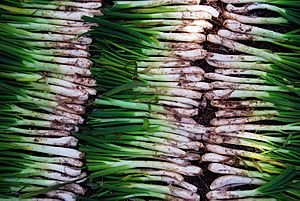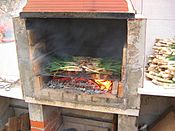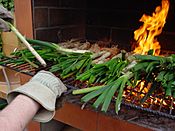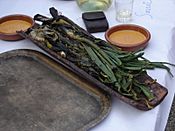Calçot facts for kids
Quick facts for kids Calçot |
|
|---|---|
 |
|
| Species | Allium cepa |
| Cultivar | Calçot |
| Origin | Catalonia (Spain) |
A calçot (pronounced "kal-SOT") is a special type of green onion. It's very popular in Catalonia, a region in Spain. People there love to eat them, especially at big outdoor parties!
These onions are milder and not as round as regular onions. They have a long white part, usually about 15 to 25 centimeters (6 to 10 inches) long. At the bottom, they are about 1.7 to 2.5 centimeters (0.7 to 1 inch) wide.
Calçots are grown in a unique way. Farmers plant them like onions. Then, they keep adding more soil around the stems as they grow. This process is called "earthing up." It helps the calçots grow long and white. Each planted bulb can grow 4 to 10 shoots. These shoots look a bit like small leeks or scallions.
The calçot and its special way of cooking come from the town of Valls in Catalonia. Every year, Valls holds a big festival to celebrate the calçot harvest. Today, thousands of eating parties called calçotades (kal-so-TAH-des) happen all over Catalonia.
At these parties, calçots are grilled over a hot fire. Then, they are wrapped in newspaper to keep them warm. They are served on terra cotta tiles. People peel them with their hands and dip them in a special sauce called salvitxada.
Contents
What's in a Name?
The word "calçot" comes from the Catalan word "calçar." This word means "to hill" or "to earth up." It describes the special way these onions are grown. Farmers add soil around the plants as they grow. This helps the calçots get their long, white shape and soft texture.
The word "calçar" also means "to shoe." It comes from an old Latin word, calceus, which was a type of shoe. This connection is because the soil "shoes" the plant, covering its lower part.
Where Did Calçots Come From?
The exact beginning of the calçot is not fully known. But one popular story says they were first grown by a farmer named Xat de Benaiges. He lived in Valls around the early 1900s.
The story says he was the first to plant onion sprouts and cover them with earth. This made the stems grow longer and stay white. This method created the unique calçot we know today!
The Calçotada Party
The most fun way to eat calçots is at a calçotada. This is a big food celebration that happens between November and April. At these parties, people eat huge amounts of barbecued calçots!
How to Eat Calçots
First, the calçots are grilled until their outer layers are black and charred. Then, they are wrapped in newspaper. This helps them steam and become tender. They are served on terra cotta tiles.
To eat them, you peel off the burnt outer skin with your bare hands. Then, you dip the soft, white part into salvitxada or romesco sauce. The green tops are usually not eaten. It's common to wear a large bib to protect your clothes from sauce stains!
What Else is Served?
Along with calçots, people often drink red wine or cava (a Spanish sparkling wine). After the calçots are cooked, pieces of meat and bread slices are often roasted over the same hot coals. For dessert, a common choice is oranges and white cava.
Gallery
- Calçot
See also
 In Spanish: Calçot para niños
In Spanish: Calçot para niños





